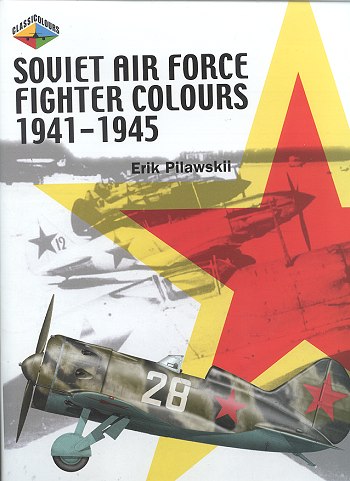 There are a
lot of camouflage and markings books out there for us to buy, many of which
are well researched and very useful to both modelers and aviation
enthusiasts alike. However, there are some areas that have had little press
and one of those is the Soviet Air Force during WWII.
There are a
lot of camouflage and markings books out there for us to buy, many of which
are well researched and very useful to both modelers and aviation
enthusiasts alike. However, there are some areas that have had little press
and one of those is the Soviet Air Force during WWII.
Many of us figured that the aircraft were either green and
black or a two-tone grey and left it like that. After all, we surmised, the
Soviets just used whatever was around (such as tractor paint) to paint
their planes. Right?
Well, though there were cases when this was true, for the
most part, the Soviet military was just like others in that they did have
specifications for colors to use on their planes. It is just that most of
us in the West were unaware of them or thought them to be inconsequential.
This book clears up a lot of misconceptions and opens a new
door for those of us who really like books on camouflage and markings. What
is really great about it is that the author didn't just use someone else's
material (as is often the case), but did a great deal of primary research
to produce this book. The result is the finest book on the subject of
Soviet Fighter camouflage to have ever been published.
All of the major fighters used by the Soviets during the
Great Patriotic War (GPW) are given coverage as are a number of prototype
aircraft that never saw production. The book is broken down into sections,
each covering a major airframe type. As a result, you have sections on the
I-16, Yak-1, Lagg-3 and Mig-3, for example. In each of these sections,
there is a complete history of the type followed by a section that shows
the many different camouflage variations used on the aircraft.
Since each factory seemed to have its own special camo
scheme, these are shown not only in color three-views of each scheme, but
also with supporting photos of planes in the various camo schemes. These
three-views are as close to the actual colors used as can be printed and I
for one was amazed at how different these colors and schemes were to some
of the Soviet planes that I've built over the years! I can see this book
being a real shake-up in the hobby when it comes to the subject and I'd not
doubt that many who make paint will be using it for an example. For those
wanting colors now, there is a large and helpful chart in the beginning of
the book that offers color equivalents including FS 595 callouts. The color
information also goes into cockpit colors, though not in the same depth as
exterior camouflage.
I can't leave this review without mentioning that the
author is on a bit of a crusade to show that Soviet aircraft were as good
if not better than anything else flown by other countries. His claim is
that the idea that Soviet planes were crude is a result of Allied and
Western propaganda and not at all true. This is repeated many times
throughout the book and the author phrases things to put Soviet aircraft in
as good a light as he can. While I'm not doubting his findings, I don't
need to be constantly reminded of it. A minor point for sure, but one that
really stuck in my mind while reading the book.
The depth of the research done by the author has resulted
in the finest book ever done on Soviet Fighter colors during the GPW. It is
a book that you really must have on your shelf if you have any interest at
all in aircraft camouflage in general or Soviet aircraft in particular. I
very highly recommend this book.
Review book courtesy of
 ,
where you can order your copy of this and many other superb aviation and
modeling books.
,
where you can order your copy of this and many other superb aviation and
modeling books.
If you would like your product reviewed fairly and quickly by a
site that has over 200,000 visitors a month, please contact
me or see other details in the Note to
Contributors.
 There are a
lot of camouflage and markings books out there for us to buy, many of which
are well researched and very useful to both modelers and aviation
enthusiasts alike. However, there are some areas that have had little press
and one of those is the Soviet Air Force during WWII.
There are a
lot of camouflage and markings books out there for us to buy, many of which
are well researched and very useful to both modelers and aviation
enthusiasts alike. However, there are some areas that have had little press
and one of those is the Soviet Air Force during WWII.